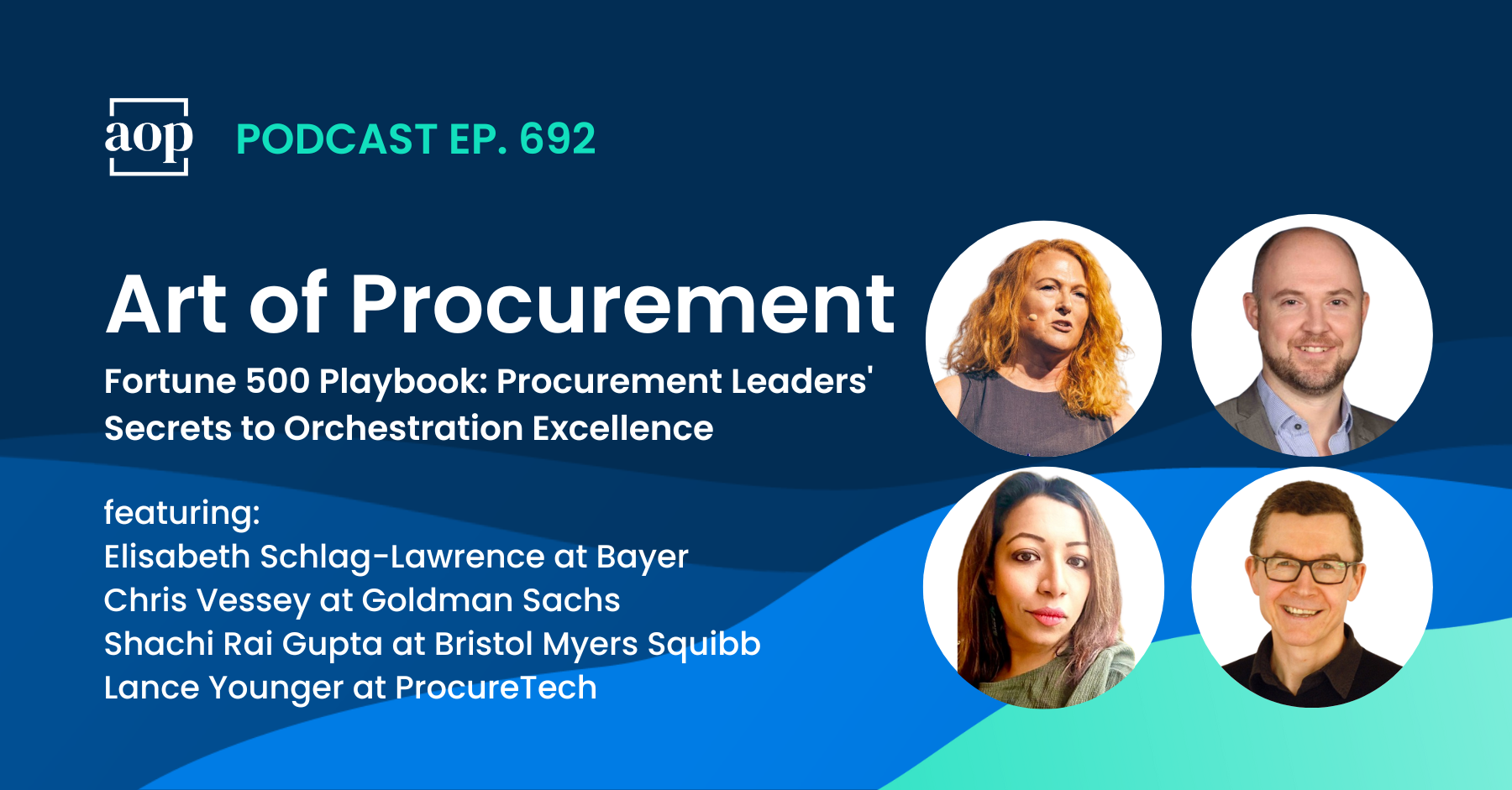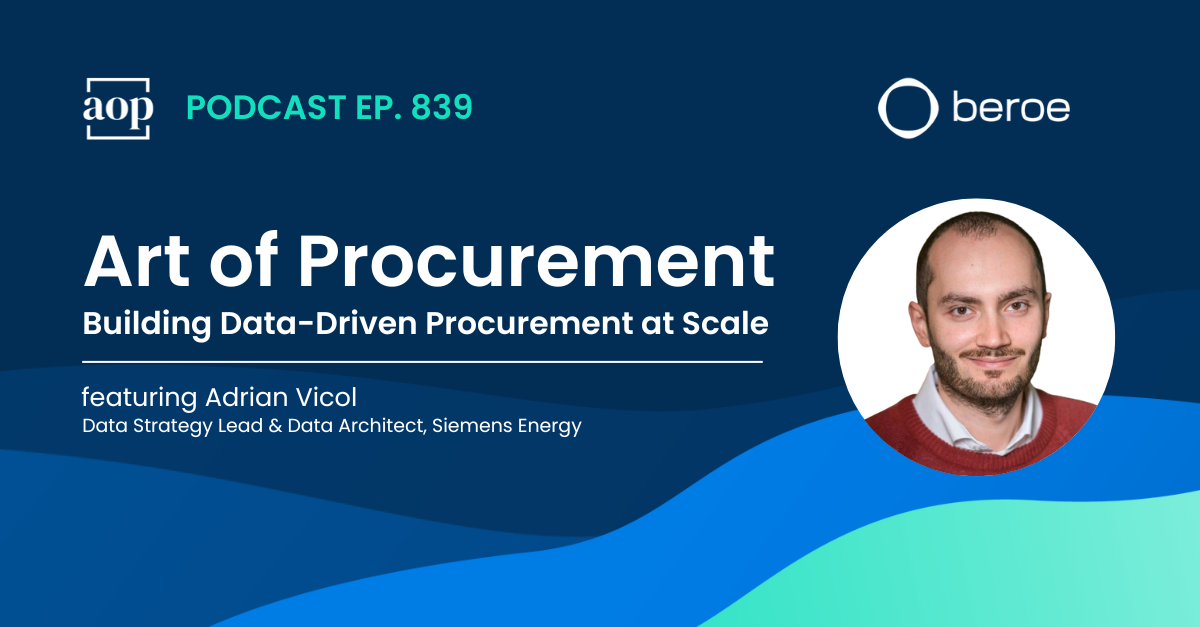5 min read
Fortune 500 Playbook: Procurement Leaders’ Secrets to Orchestration Excellence
Philip Ideson : April 28, 2024

“If you think of it simplistically, orchestration is a whole art form. You have to learn what it all means. But in so many words, it is nothing else than acting as if it is your own company. How cool is that?” – Elisabeth Schlag-Lawrence, SVP, Head of Procurement Governance and Enabling, Bayer
“Revolutionizing.” “Game Changing.” “Exciting.” “Empowering.” “Enabling.” These are just a few of the ways Fortune 500 procurement leaders describe the benefits of procurement orchestration. These benefits make it clear why procurement orchestration is undergoing rapid adoption in organizations around the world.
I recently spoke with Elisabeth Schlag-Lawrence, SVP, Head of Procurement Governance and Enabling at Bayer; Chris Vessey, Executive Director, Global Product Strategy & Transformation at Goldman Sachs; Shachi Rai Gupta, Global Head of Strategy, Intelligence and Digital Transformation at Bristol Myers Squibb; and Lance Younger, CEO of ProcureTech about their experiences with orchestration.
In the episode, which is based on a live webinar we hosted in February, they describe their journeys toward orchestration and the benefits that adopting this approach has brought to their teams and to the business.
Let’s hear, in their own words, why orchestration is such a game changer for procurement and how all organizations can borrow the concepts and frameworks of these four leading procurement teams.
Elisabeth Schlag-Lawrence, SVP, Head of Procurement Governance and Enabling, Bayer
According to Elisabeth, the procurement team at Bayer is in the early stages of procurement orchestration and piloting the program to assess what a long-term implementation should look like. This is taking place amid a large and highly visible transformation across the organization as it moves toward an operating model they call “Dynamic Shared Ownership” (DSO), which supports – exactly as the name says – a company-wide sense of shared ownership not just over one’s own function but over the entire business. It’s within this context, Elisabeth says, that she and her team are focused on creating a strong vision for the future and improving the overall user experience across the procurement tech stack.
Here’s how Elisabeth describes the ways orchestration within the new DSO model will enhance the user experience at Bayer:
“If you think of it simplistically, orchestration is a whole art form. You have to learn what it all means. But in so many words, it is nothing else than acting as if it is your own company. How cool is that?
If you end up doing that, you have to help these poor people in the business, not getting lost in 52 different tools that they have to log into. Last time, I had one of our country CFOs call us, and he said to one of my people, “I have to log into 14 different tools to get my data reports. Are you kidding me?” That is not cool anymore.
To me, as we start acting like it is our own business and we stop, if I may say, justifying why procurement exists, I personally think that the era has come for us that we can no longer say, ‘We just exist for the purpose of inventing our own world.’ Lovely, but we have all been down that road.
I don’t see that purpose until we can show our real value. Also, orchestration is enabling and empowering people and tools. To me, that is what orchestration is all about – making their life easier at the user experience.”
Chris Vessey, Executive Director, Global Product Strategy & Transformation at Goldman Sachs
Chris’s team is also in the earlier stages of procurement orchestration, and they envision it as a “revolutionary change” for the business that enables procurement – through a combination of automation, tools, and one-on-one support – to make each stakeholder feel as if they have a personal procurement support team sitting right next to them, guiding and problem-solving in real time.
Here’s what Chris has to say about the benefits of orchestration to the Goldman Sachs team:
“That humanization, as we have started to call it within Goldman, of this orchestration is critical because what I think we have realized is procurement can be undervalued sometimes. It can be looked on as being not critical for the firm to move forward by the individual users. But we know as procurement that actually the value-add is significant and, if we could, we would have a procurement professional sit next to every single user in the firm to guide them through what they have to do.
That is what orchestration lets us do because you can build a solution that has elements of automation where you automate certain parts of the flow that make sense to automate, but it also has a dynamic and a humanized nature to it, and if you design it well that lets you actually morph around the different scenarios and not feel to a user that they are stuck in some kind of impossible channel and, as their needs change, they have to restart the whole thing again, trying to find what they do differently.
Instead, they can actually move seamlessly between lanes based upon automation controls or based upon people in the loop to actually redirect them slightly or bring them back on course again, so they are not in that situation where it is all confusing to them.”
Shachi Rai Gupta, Global Head of Strategy, Intelligence and Digital Transformation at Bristol Myers Squibb
Sachi recounts a huge “mindset shift” for procurement at Bristol that happened around 2020, as the business recognized procurement’s value contribution extends far beyond the transactional or administrative. Since then, they have been on a path toward orchestration that has enabled procurement to reduce the time to market, address risk, and work toward their ESG goals. Orchestration, said Sachi, has taken procurement from “complexity and chaos” to simplicity, streamlined workflows, more visibility and traceability, and improved compliance and risk awareness.
Sachi’s experience with procurement orchestration speaks to the need for procurement to be aware of potential pitfalls in order to enjoy the true benefit and value of the model:
“One of the things we have to realize is orchestration is an ecosystem. You almost need to step back and look at the full picture to truly derive value from it. You may decide to phase it out and scale it, but when you step back, the team that designs it has to look at it holistically to derive value from it.
Investment in the right team and the right structure is key and really pulling in even the stakeholders because that has really worked for us – having the design dream team. The business is involved, and they are invested in it. Finance is involved. It is not just procurement. It is finance, suppliers, business, et cetera.
The pitfall I see is sometimes some of these platforms want to do everything. I understand the need for it because you want to cater to people who don’t have technology already, but then you are muddying the water.
At the end of the day, orchestration in my mind is the top layer. You can have somebody playing the flute, somebody playing the guitar, but we need the conductor. If the conductor also goes and starts playing the flute, then I think there is a danger in that.”
Lance Younger, CEO of ProcureTech
As Lance puts it, procurement orchestration is a “game changer for procurement and their whole digital ecosystem.” Orchestration’s impact on procurement’s ability to manage and leverage data to create value can’t be overstated, says Lance.
Here’s how he describes the full scope of procurement orchestration’s ability to streamline and unify the business:
“A lot of people talk about process orchestration, connecting different parts of your workflow together, connecting different capabilities together, end-to-end throughout procurement. But in reality, procurement orchestration is actually so much more than that.
Yes, that can help with the user experience and the user journey, but probably more importantly, it is about data, data workflow, and data process as well. By tying the data together and the process, you create a natural fabric or workflow going from one step to the other.
The nice thing about process workflow is that it can be very deep in a particular area, or it can be shallow going across your end-to-end process as well. We are seeing it being applied in both ways. Yes, it is called process, but in reality, it is process, data, and ultimately people as well.”
Subscribe to Art of Procurement
Apple | Stitcher | iHeart Radio | Email


.png)

